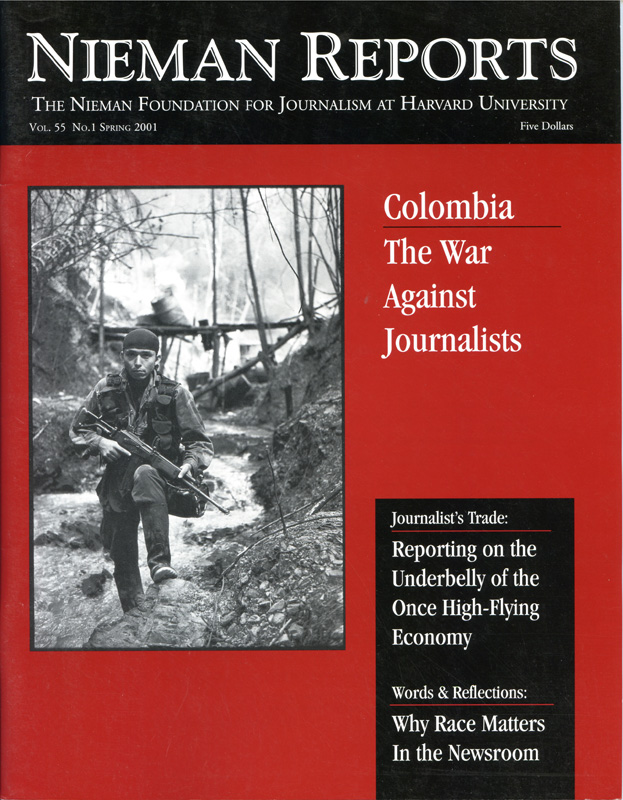
Colombia: The War Against Journalists
Reporting on Colombia’s war is extremely dangerous for journalists. For what they publish and broadcast, reporters are threatened and harassed, kidnapped and beaten, driven into exile and murdered. Only in Algeria have more journalists been murdered during recent years in retaliation for the work they do.
Every two years, a lot of political reporters and editors make a critical decision early in the campaign that members of the U.S. House of Representatives running for reelection cannot be defeated. Name recognition is too high. And their jobs come with franking privileges and other perks of office, including the ability to raise money from those whose interests they serve. Conversely, their challengers are often not widely known or well funded. Once such assumptions are made, it follows that covering these campaigns appears pointless and of little news value.
The problem is that judgment becomes a self-fulfilling prophecy. Almost all House incumbents are reelected. Of the 405 incumbents who ran last year for reelection, only eight were defeated, a mere two percent. A small number of journalists, therefore, come to play a role, maybe a decisive role, in determining the election outcomes, especially since many of the newspapers they work for hold monopoly or near-monopoly power in their communities. And it is no wonder that it has become difficult to recruit people to run against a House member, nor a surprise that House members can become complacent about their performance in office when they know the newspapers back home consider them shoo-ins at election time.
Actually, to suggest that the newspapers make an important decision on coverage may, in fact, be an overstatement. In many cases, these House races go by the board without the editors or reporters giving them any real thought. Contenders in these races might get a single feature story and/or mention in the voters’ guide in a pre-election roundup. But that is it. Only races for open seats get attention.
The “coverage” of a House race last fall in Montgomery County, Maryland, close by the nation’s capital, illustrates this problem. The Washington Post and The (Baltimore) Sun, the two major dailies read in the state, and The Associated Press, gave almost no attention to the campaign in which Representative Constance A. Morella, a moderate 69-year-old Republican running for her eighth term, was challenged by Democrat Terry Lierman, a successful 52-year-old businessman, lobbyist and community leader up for his first elective office. I volunteered for Lierman’s campaign, though I did not know the candidate when the campaign began.
Known for her community service, Morella had won 60 percent of the vote in her other reelections. So the newspapers assumed there could be no story this time. It was just another race, with Lierman about to be one more sacrificial lamb. And since no one was covering the campaign, reporters and editors failed to recognize that Lierman’s message was resonating in the largely Democratic district.
Essentially, Lierman pressed the point that it would take a gain of only six seats for Democrats to retake control of the House and oust the current leadership. He also emphasized that Morella had lost her once considerable influence in the House now that it was controlled by conservative Republicans who kept her off any of the top committees despite her seniority. The media also ignored signs that Lierman would run a well-financed campaign, putting a large amount of his own money into the race and raising a substantial amount in contributions.
The Sun did a feature story on the Morella-Lierman contest in early September. It also published a long “editorial” across the top of the page in late September that carried the headline, “Morella holds the center, delivers the goods.” It was a glowing report on her background and House career. Lierman was not mentioned. The AP ran a feature story on the campaign as well. These three articles were so laudatory of Morella that she posted them on her Web site.
Many voters in this congressional district depend on the coverage of The Washington Post. But this time the newspaper, despite its long devotion to political coverage and its substantial resources, largely stayed aloof from this campaign except for a routine voters’ guide piece and a late string of unfavorable stories about Lierman. The Post interviewed Lierman before the campaign began, presumably for a profile, but none was published. Three weeks before the election, the Congressional Quarterly reclassified the race from “safe” Republican to “leaning” Republican, the only change made among the 435 races. But even that reassessment did not persuade the Post to pay attention. Nor did the fact that Lierman attracted as many as 1,500 volunteers and campaigned relentlessly. The Post didn’t send a reporter to cover Lierman as he campaigned until two days before the election.
Despite this vacuum of campaign coverage by Post reporters, exactly a week before the election the paper ran a story concerning a $25,000 loan Lierman made in mid-1999 to Rep. James P. Moran, Jr., an old friend. Lierman was then lobbying for a bill that might have extended the patent on the popular allergy drug Claritin. Later, Moran added his name to a chain of co-sponsors of the legislation.
Reflecting its indifferent attitude toward coverage of this House race, the Post assigned only one reporter to research and write this late-breaking article, despite its complexity and potential damage to Lierman. The result was that the published story omitted In late September The (Baltimore) Sun published a long editorial which was “a glowing report on [Morella’s] background and House career. Lierman was not mentioned.” key details, such as the fact that when he became a candidate, Lierman disclosed the loan in his financial report to the House. This occurred nine months before the Post ran its story, yet went unmentioned. The story also did not state that Moran was one of 77 bipartisan co-sponsors, including some top House members, and that the bill was assigned to the House Judiciary Committee, where Moran is not a member. Instead, the story led readers to conclude that Moran was the sole or crucial co-sponsor.
When the election was over, Morella won, with Lierman getting 46 percent of the vote. One Post columnist declared this “an amazing achievement.”
In House campaigns, as in all news coverage, fairness and objectivity should be hallmarks. And that means going out and covering the candidates the old-fashioned way, with complete, balanced reports that keep readers informed about the incumbents and the challengers. It is essential that journalists not determine their political coverage by making assumptions about winners and losers.
Steve Nordlinger worked for 32 years at The (Baltimore) Sun, reporting on local and national politics, the State Department, Congress and the Soviet Union (as Moscow bureau chief), and served as an investigative reporter, feature writer, and national editor. He is now retired.
The problem is that judgment becomes a self-fulfilling prophecy. Almost all House incumbents are reelected. Of the 405 incumbents who ran last year for reelection, only eight were defeated, a mere two percent. A small number of journalists, therefore, come to play a role, maybe a decisive role, in determining the election outcomes, especially since many of the newspapers they work for hold monopoly or near-monopoly power in their communities. And it is no wonder that it has become difficult to recruit people to run against a House member, nor a surprise that House members can become complacent about their performance in office when they know the newspapers back home consider them shoo-ins at election time.
Actually, to suggest that the newspapers make an important decision on coverage may, in fact, be an overstatement. In many cases, these House races go by the board without the editors or reporters giving them any real thought. Contenders in these races might get a single feature story and/or mention in the voters’ guide in a pre-election roundup. But that is it. Only races for open seats get attention.
The “coverage” of a House race last fall in Montgomery County, Maryland, close by the nation’s capital, illustrates this problem. The Washington Post and The (Baltimore) Sun, the two major dailies read in the state, and The Associated Press, gave almost no attention to the campaign in which Representative Constance A. Morella, a moderate 69-year-old Republican running for her eighth term, was challenged by Democrat Terry Lierman, a successful 52-year-old businessman, lobbyist and community leader up for his first elective office. I volunteered for Lierman’s campaign, though I did not know the candidate when the campaign began.
Known for her community service, Morella had won 60 percent of the vote in her other reelections. So the newspapers assumed there could be no story this time. It was just another race, with Lierman about to be one more sacrificial lamb. And since no one was covering the campaign, reporters and editors failed to recognize that Lierman’s message was resonating in the largely Democratic district.
Essentially, Lierman pressed the point that it would take a gain of only six seats for Democrats to retake control of the House and oust the current leadership. He also emphasized that Morella had lost her once considerable influence in the House now that it was controlled by conservative Republicans who kept her off any of the top committees despite her seniority. The media also ignored signs that Lierman would run a well-financed campaign, putting a large amount of his own money into the race and raising a substantial amount in contributions.
The Sun did a feature story on the Morella-Lierman contest in early September. It also published a long “editorial” across the top of the page in late September that carried the headline, “Morella holds the center, delivers the goods.” It was a glowing report on her background and House career. Lierman was not mentioned. The AP ran a feature story on the campaign as well. These three articles were so laudatory of Morella that she posted them on her Web site.
Many voters in this congressional district depend on the coverage of The Washington Post. But this time the newspaper, despite its long devotion to political coverage and its substantial resources, largely stayed aloof from this campaign except for a routine voters’ guide piece and a late string of unfavorable stories about Lierman. The Post interviewed Lierman before the campaign began, presumably for a profile, but none was published. Three weeks before the election, the Congressional Quarterly reclassified the race from “safe” Republican to “leaning” Republican, the only change made among the 435 races. But even that reassessment did not persuade the Post to pay attention. Nor did the fact that Lierman attracted as many as 1,500 volunteers and campaigned relentlessly. The Post didn’t send a reporter to cover Lierman as he campaigned until two days before the election.
Despite this vacuum of campaign coverage by Post reporters, exactly a week before the election the paper ran a story concerning a $25,000 loan Lierman made in mid-1999 to Rep. James P. Moran, Jr., an old friend. Lierman was then lobbying for a bill that might have extended the patent on the popular allergy drug Claritin. Later, Moran added his name to a chain of co-sponsors of the legislation.
Reflecting its indifferent attitude toward coverage of this House race, the Post assigned only one reporter to research and write this late-breaking article, despite its complexity and potential damage to Lierman. The result was that the published story omitted In late September The (Baltimore) Sun published a long editorial which was “a glowing report on [Morella’s] background and House career. Lierman was not mentioned.” key details, such as the fact that when he became a candidate, Lierman disclosed the loan in his financial report to the House. This occurred nine months before the Post ran its story, yet went unmentioned. The story also did not state that Moran was one of 77 bipartisan co-sponsors, including some top House members, and that the bill was assigned to the House Judiciary Committee, where Moran is not a member. Instead, the story led readers to conclude that Moran was the sole or crucial co-sponsor.
When the election was over, Morella won, with Lierman getting 46 percent of the vote. One Post columnist declared this “an amazing achievement.”
In House campaigns, as in all news coverage, fairness and objectivity should be hallmarks. And that means going out and covering the candidates the old-fashioned way, with complete, balanced reports that keep readers informed about the incumbents and the challengers. It is essential that journalists not determine their political coverage by making assumptions about winners and losers.
Steve Nordlinger worked for 32 years at The (Baltimore) Sun, reporting on local and national politics, the State Department, Congress and the Soviet Union (as Moscow bureau chief), and served as an investigative reporter, feature writer, and national editor. He is now retired.


